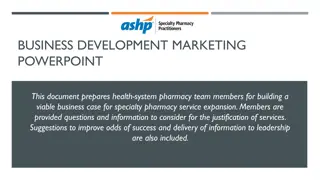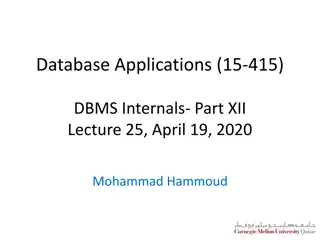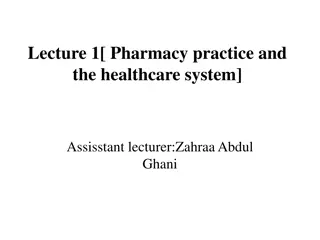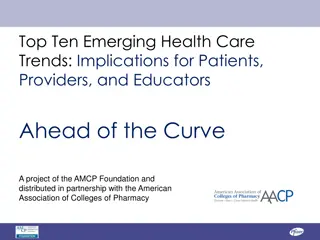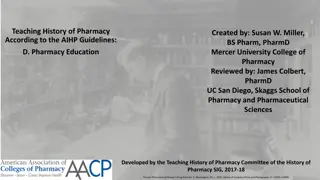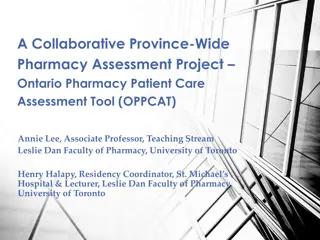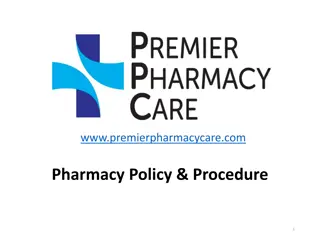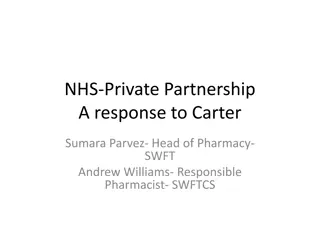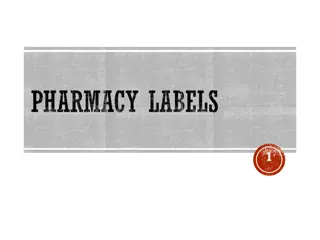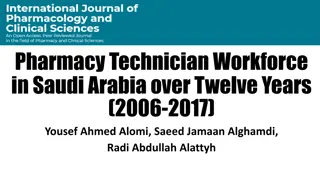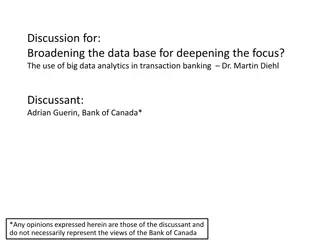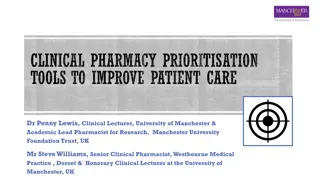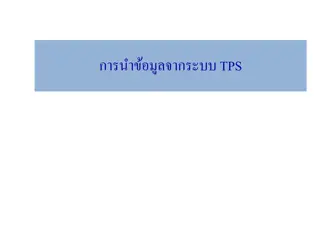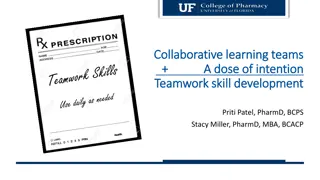Understanding Pharmacy Data Sources and Transaction Services
Exploring the Pharmacy Data Transaction Service (PDTS) and its role in collecting and analyzing pharmacy data, including details on TRICARE Pharmacy, VA Pharmacies, and common terms used in PDTS. Discover the significance of PDTS in tracking prescriptions, patient profiles, and data sources.
Download Presentation

Please find below an Image/Link to download the presentation.
The content on the website is provided AS IS for your information and personal use only. It may not be sold, licensed, or shared on other websites without obtaining consent from the author. Download presentation by click this link. If you encounter any issues during the download, it is possible that the publisher has removed the file from their server.
E N D
Presentation Transcript
Pharmacy Data VERONIKA PAV KENNELL & ASSOCIATES, INC
Objectives Describe the data source of Pharmacy Data Transaction Service (PDTS). Properly use common terms in PDTS. Properly use pharmacy specific terms in PDTS. Describe other sources of pharmacy data available. 2
TRICARE Pharmacy Pharmacy is one of the most important product lines in the MHS. Information about the TRICARE pharmacy benefit can be found at: http://www.tricare.mil/pharmacycosts. Almost all of the pharmacy data in PDTS represents care that was paid for by the MHS. The VA uses PDTS for Drug Utilization Review for dual VA/DoD eligible beneficiaries. (This care is not funded by the DHP.) VA Pharmacies reported more than 6.6 million prescriptions to date in FY18. Best guess at finding DoD/VA Dual Eligibles. PDTS is an operational centralized database system that provides a comprehensive patient medication profile for each DoD beneficiary from multiple sources system that does a drug utilization review. Provides a weekly data feed to MDR 3
PDTS File Pharmacy Data Transaction Service (PDTS) Record: Each record represents a filled outpatient prescription. Record ID: Authorization Number (AUTHNUM) 5
PDTS Data Elements Robust set of common terms in PDTS data Record ID: PDTS Authorization Number (AUTHNUM) Issue Date (DATEDISP): Represents date of PDTS DUR query. This is usually the date of issue, but may not be for refills. FY/FM and CY/CM are based on Issue Date. Geography available for patient, pharmacy and provider (prescriber) Catchment Area, PRISM Area, etc. 6
PDTS Data Elements Source System: Indicates fill location D: Direct Care M: Retail Pharmacy (MCSC) T: Mail Order Pharmacy V: Veterans Health Administration (since FY 2006) C: Direct Care, clinician administered, but not an outpatient prescription. R: Theater Medical Data Store (TMDS)/Line Unit (since FY 2011) Will be used often! Remember this one! 7
Number of Prescriptions by Year and Source Retail (M) is by far the most expensive fill location 8
Data About the Drug Dispensed National Drug Code (NDC): Most granular; no ref table! Indicates drug, dosage, package size and vendor. Generic Class (GCN): Grouping into category of all drugs that are of the same generic equivalent No Reference Table Available! Therapeutic Class (THERCLSS): Grouping based on therapeutic effect; DD Appendix 10
PDTS Data Elements Product Name: Name of drug (all caps) Quantity: # Units Dispensed Days Supply: Doesn t make sense for all medications. (i.e. take as needed) Sometimes unreliable for direct care; depends on how the prescription is ordered. (may default to 30 days) Product Form: Tablet, Inhalant, etc. Product Strength: Dosage Refill Number: 00=Initial Fill; 01=First Refill, etc 12
Days Supply and Quantity by Source System Note the differences in number of days per script in the different fill locations Mail order prescriptions tend to be more long term fills. Let s look at VA Source System a little bit more . 13
Source System: VA Top Pharmacy NPIs 16
PDTS Data Elements Generic Indicator (GENIND): Tells whether or not a generic equivalent was available. Values : M = Multi source brand N = Single source brand O = Originator brand (only on claims prior to 5/1/15) Y = Generic X = Non-drug items (only on claims prior to 5/1/15) blank = undetermined. Dispensed as Written Indicator (DAW): Indicates that the pharmacy cannot make substitutions. Number of Scripts Include this element to count prescriptions. Is 1 on all records. 17
PDTS Data Elements Data about the pharmacy Treatment DMISID: Just for direct care. Pharmacy ID (NCPDPNUM): National Council for Prescription Drug Plan Identifier Sometimes useful in identifying smaller entities within a DMISID (MTF Only). Pharmacy Name Only populated for MTFs. Not Populated for Source System VA Pharmacy National Provider ID (SITENPI): Populated for Source System VA 18
PDTS Data Elements Data about the prescriber: DEA Number: This data element historically contained DEA Number, but now generally contains the prescriber s NPI. Populated for both direct and purchased care fills. Can look up at in NPPES File. Particularly helpful if trying to link fills to orders in the purchased care. 19
PDTS Data Elements Data about the prescriber: Ordering Information (Direct care only) Information from CHCS, added to PDTS file in MDR processing. Only populated when prescription is ordered and filled at the same CHCS host. Not populated on average 26% of the time for initial fills, 46% for refills. Ordering Site: DMISID where the prescription was ordered. Ordering MEPRS Code Prof Enc Record ID (APPTIEN): Contains Record ID of CAPER where prescription was ordered. 20
Ordering MEPRS Code If Ordering MEPRS2 Code = FC then the prescription was ordered by a provider external to the MTF that issued the product. About 62% of these prescriptions are for patients who are 65 and older. Direct Care Prescriptions Filled By MTFs But Ordered Externally, FY 2018 21
CAPER and PDTS Link Results 23
Caveats and Other Things to Remember MTF Data Issues The NDC can sometimes be incorrect on direct care fills. The drug itself will usually be correct, as will the strength and product form Therefore, the therapeutic class and generic class will also usually be correct This can also cause the generic indicator to be incorrect Sometimes quantities are incorrect CHCS Pharmacy Table errors. Sometimes days supply are incorrect depends on the way that the scripts are ordered. 24
Pharmacy Examples Effects of Formulary & Benefit Changes 25
Formulary Changes Example - LIPITOR When a drug s patent runs out, generic versions usually become available at a much lower cost and the cost of the previously brand name product also declines. Lipitor is a good example of that. Almost 2 million MHS Lipitor scripts in 2011. When generic became available, Lipitor itself became much cheaper, but the generic version is even cheaper still. Saved the MHS a considerable amount of money given the prominence of this medication. Changed ordering patterns for providers throughout the MHS. 26
LIPITOR Example The MHS saved nearly $200 million dollars on this one medication when it became available as a generic in FY 2012 27
NEXIUM Example This trend is starting to repeat itself with Nexium, another common brand name drug. Generic Nexium 28
Benefit Changes DHA has made some benefit changes with respect to pharmacy copays. There is no copay for direct care scripts, or for generic scripts filled through Mail Order. Copays for retail and for brand name drugs in mail order have increased, encouraging patients to switch to cheaper source systems 29
Select Maintenance Drugs Maintenance drugs make up nearly three quarters of total pharmacy spending Drugs taken regularly for a long time (e.g. blood pressure and cholesterol drugs) In March 2014, DHA instituted a pilot for TFL beneficiaries, where they would be required to fill brand name maintenance drugs in TMOP or MTFs Patients can fill first two fills in retail before switching Patients with OHI with a prescription benefit, personal hardships, who live in a nursing home, or who live outside the US are excluded Many drugs are excluded, including those that require refrigeration, and many cancer and mental health drugs As of October 1, 2015 (FY16), this pilot was extended to all non-ADSM beneficiaries 30
Compound Pharmacy Compound drugs are: A combination of two or more drugs Prepared by a pharmacist (not mass produced) For a specific patient s individual needs In FY12, compound drugs made up 0.4% of total pharmacy spending Compound drugs are typically reimbursed at billed amounts, which led to rampant abuse peaking in FY15, costing TRICARE over $1.6 billion (16% of total pharmacy spending). The gov t has begun prosecuting those who defrauded the system: http://www.wsj.com/articles/u-s-targets-pharmacies-over-soaring-claims-to-military-health-program- 1447032619 http://www.usatoday.com/story/news/nation-now/2017/01/01/phoenix-doctor-indicted-100-million-fraud- case/96072826/ 31
Takeaways PDTS contains only outpatient dispensed prescriptions Contains data from many sources: M = Retail: most expensive, use Paid by TRICARE T = TMOP: often 90-day scripts, fastest growing, use Paid by TRICARE D = Direct Care: cheapest, use Full Cost (Allowed Amount) V = VA: Not paid for by DoD C = Clinically Administered R = Theater/Line Don t double-count when combining with other sources Use Therapeutic Class and Product Name to identify drugs Linkages to Ordering Information Direct care: Prof Enc Record ID; Ordering Site; MEPRS Code, Ordering DEA Number = Prescriber s NPI 33
Questions vpav@kennellinc.com 34






